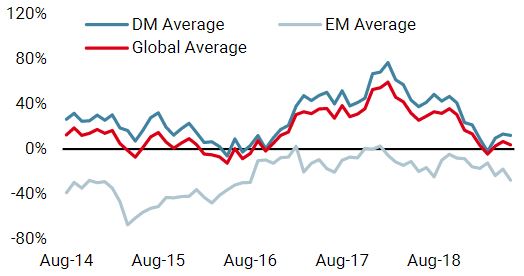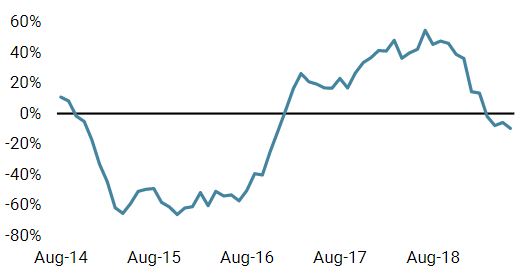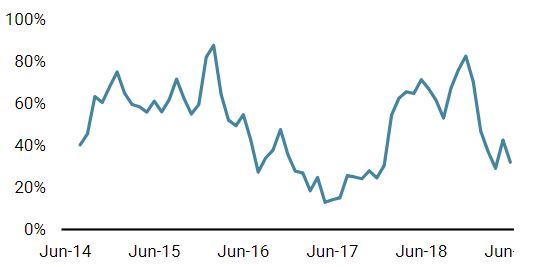Last week’s Fed meeting confirmed what many market participants had expected for a couple of months, namely that monetary policy will likely shift from patiently neutral toward easing through a combination of rate cuts and balance sheet expansion. This clear dovish signal followed comments by ECB President Mario Draghi indicating that rate cuts were on the table if the ECB decides to ease in the face of downside risks to the Eurozone. Some investors may question the Fed’s justification in making this shift, especially in light of their stable projections for growth and unemployment, but a combination of disinflationary pressures and uncertainty on external conditions are clearly the primary risks in the minds of Fed governors. We believe the 1995 example is most relevant today, when the Fed cut rates after a sustained trend of tightening moderated inflation pressures. Markets have heard this song before and will keep on dancing to the familiar beat. One of the key supports for financial markets this year has been investor expectations of easier monetary policy. The shift from pricing rate hikes and balance sheet reduction to rate cuts and asset purchases has more than offset concerns about global growth and trade uncertainty. Last week, the Fed largely delivered on investor expectations, confirming the dovish pivot they have been communicating since the end of last year. In our view the highlights from the meeting are:„KEEP ON DANCING“ – The Jacksons, 1976
What’s Next?
The Fed is One Step Away From its First Rate Cut Since 2008
- Projections for the target rate (the “dot plot”) were revised down significantly toward market pricing (for the second time) and now point to no hikes for this year. Importantly, the median longer-term neutral rate is now 2.5%, indicating that Fed members think the current level of rates is sufficient to promote growth in the absence of material downside risks.
- Indeed, their projections for growth and unemployment did not change much and Chairman Powell confirmed that growth and the labour market remain “solid“.
- However, inflation projections were revised down significantly from 1.8% (or close to their 2% target) to 1.5% (or markedly below target) for 2019.
- Their statement dropped the “patience” references and Powell confirmed they are ready to act if needed. And, for the first time in a while, the board is split between doves and hawks.
In our view, the 1995 case is most relevant to today’s context, although it is not a perfect analogy. Starting in early 1994, the Fed raised rates continuously from 3% all the way to 6% in the span of 15 months. This contained price appreciation but business spending was showing signs of slowing down and so, in July 1995, the Fed, under the leadership of Alan Greenspan, thought a more accommodative policy was apt and cut rates by 0.25%. Today, the Fed has engaged in slower and less drastic policy tightening, but they are also seeing, as they did in 1995, inflation under control while risks to growth mount. By cutting rates pre-emptively in 1995, the Fed was able to extend the economic expansion until the tech bubble burst. Back to the future, investors today expect the Fed to take the same action this year and succeed in supporting the expansion. One other interesting parallel is noteworthy: back in 1995, President Clinton was a year out from running for re-election, and the easier policy helped to avoid a possible recession that would have made his re-election chances much tougher. The New York Times opened their 7 July 1995 story on the rate cut by writing, “Under mounting political and economic pressure to stave off a possible recession, the Federal Reserve reduced short-term interest rates for the first time since 1992.” We could easily imagine reading a very similar headline in the next few months.Roads? Where We’re Going, We Don’t Need Roads

As in 1995, we expect risky assets to extend their gains over the medium term. Lower bond yields should lower debt service costs and promote credit creation. Without an imminent threat of recession, growth-oriented assets should benefit from both cash-flow growth and lower discount rates. One countervailing headwind is that valuation for some assets has become quite rich. In particular, the carry in G10 nominal bonds and high yield credit spreads looks quite expensive historically (though less so when compared to other assets). In equities, the S&P 500 index is expensive by almost any metric. Whether you consider the underlying assets, earnings, dividends or cash flows that you get for the price you pay for US stocks, you are getting much less today than you would have historically. However, the elephant in the room is the US-led trade war and resulting uncertainty. A key question for investors is whether the impacts will be felt primarily via the demand or supply channel. In the Fed’s view, the impacts will largely be on the demand side and not lead to a significant pick-up in prices. Outside of the macro impacts to growth and inflation, we are concerned about the sensitivity of market sentiment to the ebb and flow of trade negotiations. While the latest news has been positive and a meeting between President Trump and Xi is likely next week, we are not convinced the thorny issues can be easily resolved. Nevertheless, we prefer to remain risk-on to benefit from the tailwinds of an easier Fed and tactically hedge tail risk via options.Got Our Dancing Shoes On, but Listening Closely to the Beat

Keep on Dancing

Our medium-term views remain cautious, and we are pairing an overweight in government bonds with an underweight in high yield corporate credit. We are also complementing our equity exposure with options to protect the portfolio in the case of equity drawdowns. Over the month of June so far, the Uni-Global – Cross Asset Navigator fund is up 3.1% versus 6.5% for the MSCI AC World index and 1.1% for the Barclays Global Aggregate index (USD hedged). Year-to-date, the Uni-Global – Cross Asset Navigator has returned 6.8% versus 16.1% for the MSCI AC World index, while the Barclays Global Aggregate index (USD hedged) is up 5.7%. Strategy Behaviour
Performance Review
Unigestion Nowcasting
World Growth Nowcaster

World Inflation Nowcaster

Market Stress Nowcaster

Weekly Change
- Our world Growth Nowcaster was steady over the week, with a slight improvement in developed economies offset by weakness in the emerging world.
- Our world Inflation Nowcaster was also steady this week, as most countries did not see material changes to inflationary pressures.
- Market stress moved down further, as spreads became more supportive.
Sources: Unigestion. Bloomberg, as of 24 June 2019.
Past performance is no guide to the future, the value of investments can fall as well as rise, there is no guarantee that your initial investment will be returned. Important Information Past performance is no guide to the future, the value of investments, and the income from them change frequently, may fall as well as rise, there is no guarantee that your initial investment will be returned. This document has been prepared for your information only and must not be distributed, published, reproduced or disclosed by recipients to any other person. It is neither directed to, nor intended for distribution or use by, any person or entity who is a citizen or resident of, or domiciled or located in, any locality, state, country or jurisdiction where such distribution, publication, availability or use would be contrary to law or regulation. This is a promotional statement of our investment philosophy and services only in relation to the subject matter of this presentation. It constitutes neither investment advice nor recommendation. This document represents no offer, solicitation or suggestion of suitability to subscribe in the investment vehicles to which it refers. Any such offer to sell or solicitation of an offer to purchase shall be made only by formal offering documents, which include, among others, a confidential offering memorandum, limited partnership agreement (if applicable), investment management agreement (if applicable), operating agreement (if applicable), and related subscription documents (if applicable). Please contact your professional adviser/consultant before making an investment decision. Where possible we aim to disclose the material risks pertinent to this document, and as such these should be noted on the individual document pages. The views expressed in this document do not purport to be a complete description of the securities, markets and developments referred to in it. Reference to specific securities should not be considered a recommendation to buy or sell. Investors shall conduct their own analysis of the risks (including any legal, regulatory, tax or other consequences) associated with an investment and should seek independent professional advice. Some of the investment strategies described or alluded to herein may be construed as high risk and not readily realisable investments, which may experience substantial and sudden losses including total loss of investment. These are not suitable for all types of investors. To the extent that this report contains statements about the future, such statements are forward-looking and subject to a number of risks and uncertainties, including, but not limited to, the impact of competitive products, market acceptance risks and other risks. Actual results could differ materially from those in the forward-looking statements. As such, forward looking statements should not be relied upon for future returns. Targeted returns reflect subjective determinations by Unigestion based on a variety of factors, including, among others, internal modeling, investment strategy, prior performance of similar products (if any), volatility measures, risk tolerance and market conditions. Targeted returns are not intended to be actual performance and should not be relied upon as an indication of actual or future performance. Data and graphical information herein are for information only and may have been derived from third party sources. Unigestion takes reasonable steps to verify, but does not guarantee, the accuracy and completeness of this information. As a result, no representation or warranty, expressed or implied, is or will be made by Unigestion in this respect and no responsibility or liability is or will be accepted. All information provided here is subject to change without notice. It should only be considered current as of the date of publication without regard to the date on which you may access the information. Rates of exchange may cause the value of investments to go up or down. An investment with Unigestion, like all investments, contains risks, including total loss for the investor. Uni-Global – Cross Asset Navigator is a compartment of the Luxembourg Uni-Global SICAV Part I, UCITS IV compliant. This compartment is currently authorised for distribution in Austria, Belgium, Denmark, Finland, France, Germany, Ireland, Italy, Luxembourg, Netherlands, Norway, Spain, UK, Sweden, and Switzerland. In Italy, this compartment can be offered only to qualified investors within the meaning of art.100 D. Leg. 58/1998. Its shares may not be offered or distributed in any country where such offer or distribution would be prohibited by law. No prospectus has been filed with a Canadian securities regulatory authority to qualify the distribution of units of these funds and no such authority has expressed an opinion about these securities. Accordingly, their units may not be offered or distributed in Canada except to permitted clients who benefit from an exemption from the requirement to deliver a prospectus under securities legislation and where such offer or distribution would be prohibited by law. All investors must obtain and carefully read the applicable offering memorandum which contains additional information needed to evaluate the potential investment and provides important disclosures regarding risks, fees and expenses. All investors must obtain and carefully read the prospectus which contains additional information needed to evaluate the potential investment and provides important disclosures regarding risks, fees and expenses. Unless otherwise stated performance is shown net of fees in USD and does not include the commission and fees charged at the time of subscribing for or redeeming shares. Unigestion UK, which is authorised and regulated by the UK Financial Conduct Authority, has issued this document. Unigestion SA authorised and regulated by the Swiss FINMA. Unigestion Asset Management (France) S.A. authorised and regulated by the French Autorité des Marchés Financiers. Unigestion Asia Pte Limited authorised and regulated by the Monetary Authority of Singapore. Performance source: Unigestion, Bloomberg, Morningstar. Performance is shown on an annualised basis unless otherwise stated and is based on Uni Global – Cross Asset Navigator RA-USD net of fees with data from 15 December 2014 to 24 June 2019.Navigator Fund Performance
Performance, Net of Fees
2018
2017
2016
2015
Navigator (inception 15 December 2014)
-3.6%
10.6%
4.4%
-2.2%
